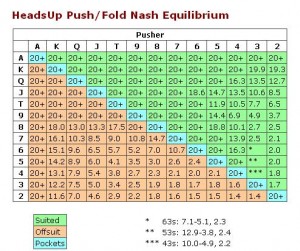 A friend asked me the other day what you do when you’re pitted heads-up against a maniac whose main move is to go all-in. This is definitely an intimidating concept too because your opponent is putting you up to a difficult decision every time. Fortunately, you can make these decisions a lot less difficult by using the NASH Equilibrium.
A friend asked me the other day what you do when you’re pitted heads-up against a maniac whose main move is to go all-in. This is definitely an intimidating concept too because your opponent is putting you up to a difficult decision every time. Fortunately, you can make these decisions a lot less difficult by using the NASH Equilibrium.
If you haven’t heard of the NASH Equilibrium, it’s basically just an old game theory that shows when it’s optimal to either shove or call an all-in move against another opponent. The nice thing about the NASH Equilibrium is that it enables you to make the best move possible (when it comes to shoving or calling heads-up). And the only way that your opponent can match these optimal moves is if they’re using the NASH Equilibrium as well.
For example, let’s say that your opponent goes all-in and you’ve got 20 big blinds left; by looking at the NASH Equilibrium chart, you can call with a wide range of hands while having 20 BB including pocket 3’s, QJ, QT, and even K2. As you may have guessed, using this chart doesn’t mean that you will win every time. However, the idea is that you gain a slight advantage over the maniac opponent who goes all-in frequently.
Another thing to keep in mind is that you shouldn’t become a shove-aholic yourself either just because you know the NASH Equilibrium. Really good players will pick you apart with this strategy, and it won’t do much to further your poker career if you plan on moving up limits one day.
Aside from using the NASH Equilibrium, you can always just wait for a good hand and call the opponent. But if you don’t know exactly what constitutes a good hand in comparison to your blinds, revert back to the NASH Equilibrium.